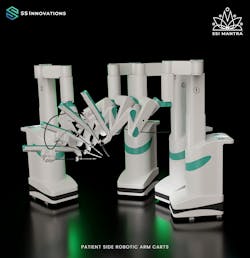Drive Tapes Prove Essential in Groundbreaking Robotic Surgery Technology
Based in northern India, SS Innovations (SSI) is revolutionizing robotic surgery with a solution that is affordable and accessible to underserved markets. Led by Dr. Sudhir Srivastava, the company has been operating in the field of medical robotic technology for the past decade with the ultimate goal of improving the quality of medical services for patients all over the world.
The company’s SSI Mantra Surgical Robotic System needed to incorporate belts and pulleys in its system’s robotic arms. Due to the highly delicate nature of surgery, the solution needed to be small and strong with zero risk of backlash. That’s where Belt Technologies, Inc., came in.
The SSI Mantra features a modular design of up to five robotic arms on individual motorized carts, allowing them to be placed anywhere throughout an operating room. Depending on the procedure, medical professionals use between three and five of the arms through a central Surgeon Command Center that includes a high-definition monitor and ergonomically designed hand controls.
Each of the Mantra system’s five arms contains three joints. The individual joints are made up of two pulleys and two separate drive tapes for a total of up to 30 belts per system. These robotic arms must operate in conjunction with one another in a very confined space while holding small instruments. For this reason, the pulleys included in the system have to be as small as possible. Additionally, due to the delicate nature of surgery, the motion of these robots has to be entirely jerk-free with zero backlash.
“The biggest constraint our engineers encountered for this system was the need to decrease the size of the pulleys while maintaining the relative strength of a thicker metal drive tape,” said Brian Harbison, Managing Director of Belt Technologies Europe Ltd. “As a general rule of thumb, the thicker the belt, the larger the pulley needs to be to ease the bending stresses on the belt.”
He continued, “Our solution was to incorporate two PureSteel drive tapes, each with six layers of 0.127-millimeter thick stainless steel, stacked on top of each other and precision welded to form one uniform body. This multilayered belt configuration allows for a reduced pulley diameter, and the design’s increased cross-sectional area permits the system to carry heavy working loads.”
The pulleys are designed to only rotate 180 degrees, which means there is zero risk for quick, jerky motions. The two drive tapes work in tandem, with one propelling forward and the other driving the reverse motion. Given the inelasticity of steel, this design handles rapid acceleration and reversing without inducing any backlash.
In addition to offering unparalleled precision and control, robot-assisted surgery allows surgeons in major metropolitan areas to operate at a distance, potentially expanding access to care for patients in a broader geography. However, the cost of the technology has long been cost-prohibitive for smaller hospitals. SSI is now producing its Mantra system at a fraction of its competitors’ cost, which makes it more accessible.
In January 2023, Dr. Diwakar Pandey became the first surgeon in the world to perform thoracic surgery with the system. That procedure was a great success, and it’s not the only one; the first SSI Mantra system has already completed more than 100 successful surgeries since it was clinically implemented. SSI currently has orders for three dozen more robots over the next year, with planned yearly production increases for the foreseeable future.
Belt Technologies, Inc. has been producing custom metal belt conveyor solutions for new and existing conveyor systems for more than 50 years. To learn more about Belt Technologies and metal conveyor belts, visit belttechnologies.com.












